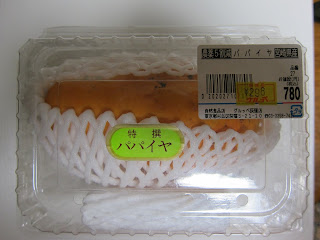hakutou, a delicious sweet tender white peach full of gentle nectar
and kyohou, very large sugary juicy grapes.
In Japan it is rare to find "organic" fruits. I buy most of my food at a local natural food store,
but almost all the fruits have been sprayed and probably are grown with some chemical fertilisers. The main difference with fruit sold at a natural food store is that they have been sprayed fewer times. The label on the hakutou peach says 50% less and the kyohou grapes says 70% less. That's great!
But, that actually tells me very little about these fruits. Instinctively, I feel good about buying these over the conventional fruits. Like buying "organic" or "fair trade" or "now 20% more!" But what do these marketing terms really mean?
And how do I consciously and unconsciously respond to them?
For instance, the label on the fruit indicates 50% less spraying.
50% less than what?
How many times were the fruits sprayed?
What was sprayed on them?
When were they sprayed?
How does the spraying affect the farmer, the environment, and the person who eats it?
I did end up in a conversation with the storekeeper about this, and she was in agreement about the superficiality of that label (eg 50% less). It's a dilemma for them, as its must less attractive to buy fruit that's labeled "sprayed 6 times with chemicals" than "50% less spraying." In fact, most people probably don't want to know about the spraying, sticking to conventional fruits that have no information about the pesticides used (and are more available, but not necessarily cheaper).
食材はなるべく自然食品店で買っています。
自然食品店でなくても、
日本の果物は高い!
不思議な事に日本の自然食品店では有機野菜が揃っていても、
有機果物を見る事がほとんどありません。
僕が知る限り、
有機果物の入手源は木村さんの奇跡の林檎と近所のお庭だけです。
アメリカの西海岸では大体どこででも安く手に入るのに。
その違いは何なのでしょう?
気候?技術?もしくは文化とマーケット?
とても残念な事です。
自然食品店の果物の利点といえば、
農薬の散布量だそうです。
例えば、写真の白桃は農薬5割減で巨峰は7割減と表示されています。
農薬が少ない方がいいと思いますが、
何割減の表示だけでは物足りない気がします。
例えば、何に比べて何割減なのか?
何回どのような農薬を散布しているか?
いつ散布されたのか?
それらはどのように農家、環境、
そして食べる人に影響を及ぼすのか?
これらの答えこそが健康や環境にケアする為の
有力な情報なのではないでしょうか?
店員の人にこのようなお話をした時、 同感していました。
お店側としては難しいとこです。
例えば、【農薬50%減】と【OO農薬7回散布】の間では
一番目の表示の方が売れるでしょう。
寧ろ何も表示がない方が気分よく消費できるかもしれません。
消費文化のモットーは
【知らぬが仏】
Papaya from Miyazaki prefecture, South West Japan.
Every time I buy fruit in Japan,
I have a moment of mental hesitation.
Because I really don't like buying toxic waste.
"Buy something and get tons of plastic trash free"
seems to be the message.
The unyielding amount of plastic packaging is extremely disturbing.
Whether it be the kyoho grapes in a plastic bag or
worse yet,
the soft papaya nestled in a styrofoam net,
encased in a plastic case,
to be enveloped in a thin plastic bag at the register,
and finally deposited in a larger plastic bag with other plastic packed goods.
Toxic consumer-culture mindlessness at its finest.
I'm a bit bitter about becoming a full-time consumer again.
Here is how I see the absurdity.
Plastic is made from a dwindling resource of fossil fuels. -not good
In Japan, plastic bags will most likely be burned or down-cycled... -not good
...releasing toxins, -definitely not good
such as environmental hormones into the environment. -bad
What a wasteful and toxic practice with little benefit.
So why do we do this?
And how do we change it?
Yes, the fruits are delicious and I'd like to just simply enjoy,
but as a part-time critical consumer,
I am really concerned about these realities.
I guess the trick is to be critical in a nourishing way,
and not being stressed.
All that said,
my favorite fruits are still hakutou peach, kyoho grapes, and nashi (Japanese pear).
I love them!
And mangos (not in Japan).
宮崎産のパパイヤ。
日本で果物などを消費する時に一番ためらってしまう理由は、
日本で果物などを消費する時に一番ためらってしまう理由は、
プラスチックのゴミを一緒に渡さられてしまう事です。
例えば、上のパパイヤは発泡スチロールのネットに包まれていて、
プラスチックのケース付きで売られています。
さらには、薄いプラスチック袋に入れられる事があり、
最終的には他のプラスチック包みの商品と一緒に、
大きなポリ袋で渡されます。
おかしくありませんか?
プラスチックは貴重な石油資源からつくられています。
それらの殆どは全部燃やされるかダウンサイクルされてしまいます。
そして、生産から最終処理まで有毒物質(環境ホルモンなど)が放出され、
それらは空気や食糧を通して僕たちの体に侵入して、
体に害を与えるようです。
生産された瞬間から有害なゴミとなる運命なのです。
全ては消費の為に!
まさしく【有毒文化】
日本だけでも何千万人の人があらゆるプラスチック包装を 毎日捨てているのです。
日本に帰るたんびに唖然としてしまいます。
なぜこのような明らかに損が多い行為を この時代になっても普通に続けられるのか?
勿論、自分の袋を持っていくのは一つの手段ですし、
勿論、自分の袋を持っていくのは一つの手段ですし、
僕の場合はそのまま商品を腕に抱えながら持ち帰る事が多いのですが、
結局ある程度の包装は買わざる終えないのです。 例えば、桃の周りのネットやブドウの袋。
アメリカでは野菜や果物に関しては、
スーパーででも商品だけを買う事ができます。
つまり、プラスチックのゴミを買わなくてもすむのです。
でも、やっぱり僕の好物は日本の白桃や巨峰と梨です。
あとは(日本では買いませんが)マンゴー。
もうすぐ大衆の意識が変わらざる終えない時が来ると思います。
ポスト消費文化の時代。
気象変動、ピークオイル、経済の不安定化、福島原発などは
消費文化の崩壊の証ではないでしょうか。


I've always found it difficult dealing with all the packaging in Japan. Refusing a shopping bag always seems to make the people working the registers uneasy.
ReplyDeleteI was happy when the government began serious recycling programs in 1998. I later learned that the reason was that all the dioxin created by 燃えないごみ gave Japan one of the highest dioxin rates in the world. They believed that this was breaking down DNA chains in male sperm, contributing to the falling birthrate (and not the more realistic reasons like insufficient incentives to bring young mothers back into the workforce). So recycling got better, albeit for the wrong reasons...